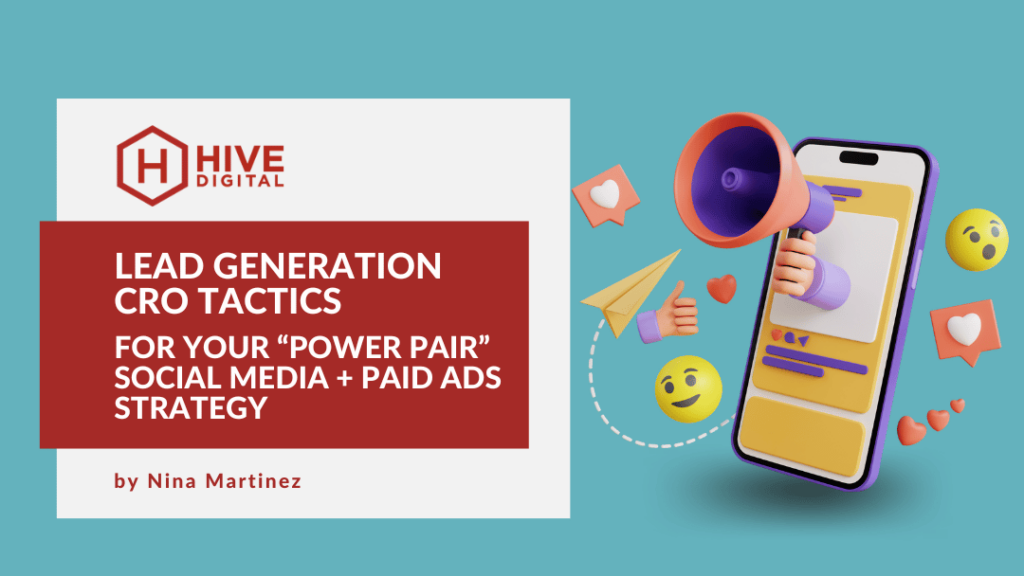When leveraging both social media and paid ads for lead generation, the landing page experience is crucial for converting traffic into tangible leads. This section of the six-part series “The Power Pair: Social Media + Paid Ads, Benefits and Best Practices for Lead Gen” will explore the methodology and approach to creating effective landing pages–emphasizing the importance of aligning page content with ad promises, user intent, and motivations–while also highlighting additional areas of opportunity that drive conversion performance.
Methodology and Approach
Tried and true, the most important elements for a positive landing page experience fall into the following themes: Aligning with User Intent, User-Centric Design, Optimized Call-to-Actions (CTAs), Trust Building, Mobile Optimization, and Testing for Continuous Improvement.
Aligning with User Intent
-
- Understanding Motivation: Recognize the motivations and needs of your target audience. Tailor your ads and respective landing page content to address these factors directly, offering solutions and benefits that resonate with them.
-
- Ad Consistency & Relevance: Ensure that the landing page mirrors the promises made in your ads. This includes matching the headlines, visuals, and value propositions to create a seamless transition from the ad click to the landing page. Content that appears irrelevant to the user can lead to frustration and lost leads.
-
- Value Proposition and Unique Selling Proposition: Clearly communicate the value proposition and benefits of your offer. Highlight how your product or service solves the user’s problem or meets their needs, as well how your solution differs from competitors.
-
- Message Match: Users click on ads with specific expectations. If the landing page content aligns with these expectations, trust is built, and users are more likely to convert. Inconsistent messaging can lead to confusion and high bounce rates that ultimately impact lead conversion.
-
- Visual Cohesion: Use similar imagery and design elements from your ads on the landing page. This visual consistency reassures users that they have landed in the right place.
User-Centric Design
-
- Clarity and Simplicity: Design with clarity, using concise language and a clean layout. Avoid clutter to help users focus on the key message and call to action (CTA).
-
- Personalization: Utilize data from social media and paid ads to create personalized landing page experiences. Dynamic content that changes based on user behavior or demographics can significantly enhance engagement and conversion rates.
Optimized CTAs
-
- Prominent and Clear CTAs: Position CTAs strategically, making them easy to find and compelling. Use action-oriented language that tells users exactly what to expect (e.g., “Download Your Free Guide” or “Start Your Free Trial”).
-
- Multiple CTA Points (on longer pages) and/or Softer CTAs: Include multiple CTA points throughout the page, especially in longer landing pages. This ensures that users have ample opportunities to convert without scrolling back up. Additionally, consider the value of “softer,” secondary CTAs that may be paired alongside a primary call-to-action, or presented in other relevant parts of the landing page.
Trust-Building
-
- Social Proof: Include testimonials, reviews, case studies, and trust badges to build credibility and trust. Social proof can significantly influence a user’s decision to convert.
-
- Transparency / Expectations: Be transparent about what users can expect after they convert. Clearly explain the next steps, whether it’s receiving an email, a call, or immediate access to a resource.
Mobile Optimization
-
- Responsive Design: Ensure your landing page is fully responsive, providing a seamless experience across all devices. With a significant portion of traffic coming from mobile users, this is critical for maintaining engagement.
-
- Fast Load Times: Optimize images, scripts, and overall page performance to achieve fast load times. Slow pages can deter users, increasing bounce rates and reducing conversions.
A/B Testing and Continuous Improvement
-
- A/B Testing: Continuously test different elements of your landing pages, such as headlines, images, CTAs, and forms, to identify what resonates best with your audience. Use the insights gained to make data-driven decisions.
-
- Analytics and Feedback: Regularly analyze performance metrics and user feedback to refine and improve your landing pages. Understanding how users interact with your page can uncover areas for enhancement.
By meticulously crafting landing pages that reflect the intent and promises of your social media and paid ads, you create a cohesive and compelling user experience that significantly boosts your conversion potential. Remember, the landing page is where your ad spend meets user action–and optimizing this touchpoint is key to maximizing your conversion efforts and driving lead generation efforts.
If you’re interested in learning more about these tactics and/or how they can be applied to your digital strategy, feel free to connect with our team for your free consultation.










